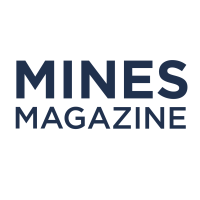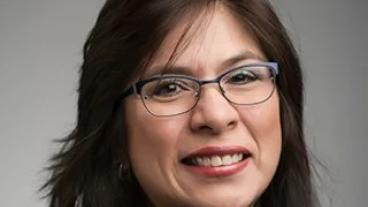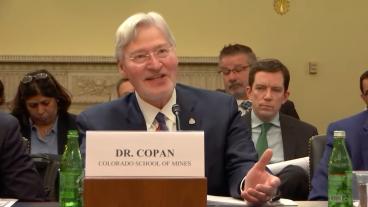Mines researchers seek concrete solutions to infrastructure challenges
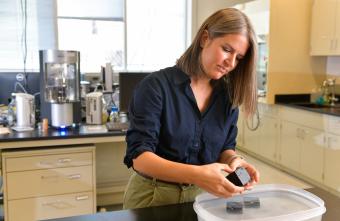
Lori Tunstall, assistant professor of civil and environmental engineering, handles a sample of a carbon-sequestering material called biochar in her laboratory. Incorporating biochar into concrete could offset the carbon footprint of concrete by at least 45 percent.
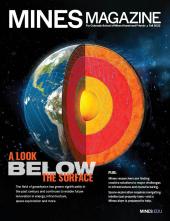
By Sarah Kuta, Special to Mines Magazine
Concrete is the second-most consumed material in the world, second only to water. Used to construct buildings, roads, bridges, dams and many other pieces of vital infrastructure, this versatile material is everywhere. But its widespread use comes at a cost: By some estimates, the concrete production process is responsible for up to 8 percent of the world’s carbon dioxide emissions.
The solution involves several key ideas: Improving durability
Lori Tunstall, assistant professor of civil and environmental engineering, is developing novel methods of improving concrete to help lower its overall environmental footprint.
She’s trying to help make concrete more durable so it can stand up to the punishing freeze-thaw cycle that exists in many cold climates, as well as other causes of degradation that, over time, cause concrete to crack, crumble and break apart. Concrete that lasts longer doesn’t need to be replaced as often which, in turn, will help reduce the demand for the heavy CO2-emitting production process.
To improve durability in the long term, she’s studying the basic material science properties of existing air-entraining admixtures, which create air pockets that provide space for water to grow into ice crystals as it freezes within the concrete.
“There are still just a lot of unknowns in the concrete industry,” she said. “We haven’t investigated the fundamentals that control the processes because they’ve always just worked—it’s one of those, ‘if it’s not broken, don’t fix it’ kind of things. But now that the admixtures are getting much more complicated, we’re trying to understand the fundamentals.”
Working sustainability into the equation
Tunstall is also addressing CO2 emissions head-on by experimenting with incorporating biochar, the umbrella term for the carbon-sequestering material produced from biomass sources, such as wood chips and agricultural waste products, into concrete.
“With the incorporation of biochar into concrete, we’re able to replace 15 percent of the cement with this biochar additive, and we estimate that will offset the carbon footprint of concrete by at least 45 percent,” she said. “It doesn’t get us to carbon-neutral, but it gets us in that direction, so perhaps coupled with some of these other techniques, it could actually be a viable way to get us there.”
Developing alternative construction materials from mine tailings
With the renewed focus on infrastructure, there’s also a greater need for construction materials across the country. Reza Hedayat, associate professor of civil and environmental engineering, is working to meet that demand while also reducing the environmental impact of another industry: mining. In collaboration with Mines’ Center for Mining Sustainability, Hedayat is exploring how to reuse leftover minerals from mining operations in bricks, tiles, aggregates, ceramics and concrete additives. His research has the added benefit of helping the mining industry reduce the environmental and economic impact of the 10 billion tons of waste materials, also known as tailings, it produces every year.
Evaluating existing infrastructure
Before they begin replacing America’s existing infrastructure, engineers and construction crews first need to evaluate it—and, to do that, they need practical, cost-effective techniques that don’t damage the structure or delay its operation. Hedayat is also innovating on that front. By designing and conducting highly controlled experiments, his group is investigating what’s happening inside materials and structures at various points in time—without damaging them in the process.
For example, he collaborated with Kiewit Corporation to evaluate and test different methods of detecting potential voids caused by water washout in the grout behind concrete segments of tunnels being built in New York, a process that historically involved drilling verification holes. Thanks to his findings, on-site construction engineers were able to use ground-penetrating radar, which emits an electromagnetic wave pulse and measure the return time and strength of the reflection, to ensure the safety and stability of their projects.
“In some environments, there is a high potential for the grout to wash out behind the tunnel segments that would compromise the integrity of the tunnel support system,” he said. “Detecting the voids behind the segments allows the tunnel contractor to perform secondary grouting and fill any remaining void spaces. The assessment is important to ensure proper support of the tunnel and the ground around it.”

